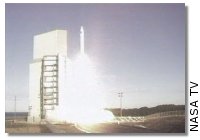Kodiak Star Mission Launch Successful

Lockheed Martin’s Athena 1 launch vehicle successfully launched the Kodiak Star Mission this evening at 10:40 p.m. EDT. This was the first launch from the new Kodiak Launch Complex on Kodiak Island in Alaska.
The Kodiak Star Mission carried four satellites into Earth orbit. Three of the satellites were provided by the Department of Defense Space Test Program (STP);
PICOSat, PCSat and Sapphire. The fourth satellite is the NASA-sponsored Starshine 3.
NASA’s spacecraft in the Kodiak Star mission is Starshine 3, a satellite program developed by the Rocky Mountain NASA Space Grant Consortium and built by the Naval Research Laboratory. The Starshine 3 satellite, about one meter in diameter and weighing about 200 pounds, is covered with front-surface aluminum mirrors. They were machined by technology students in Utah and polished by participating grade schools from all over the world. Once the satellite is in orbit the students will visually track the satellite and report their findings on the project’s web site.
PICOsat, the primary Department of Defense Satellite, is a technology demonstration satellite carrying four experiments in the areas of vibration isolation technology, ionospheric observations and polymer battery characteristics. PICOsat was built at Surrey Satellite Technology Limited (SSTL) in the United Kingdom.
The second DoD spacecraft is a Prototype Communications Satellite (PCSat), operating in the amateur radio band, designed and manufactured by Midshipmen of the United States Naval Academy. It will become part of the amateur radio community’s Automatic Position Reporting System (APRS) in low earth orbit receiving digitized identity and position data from amateur radio operators and transmitting it to one or more ground stations.
The third DoD spacecraft is SAPPHIRE, a micro-satellite designed and built by students at Stanford University and Washington University-St. Louis. The primary mission of Sapphire is to space-qualify two sets of “Tunneling Horizon Detector” infrared sensors designed and built by the Jet Propulsion Laboratory and Stanford University. Secondary experiments include a digital camera and voice synthesizer.
All four satellites deployed successfully.
Launch Video
Related Web Sites








